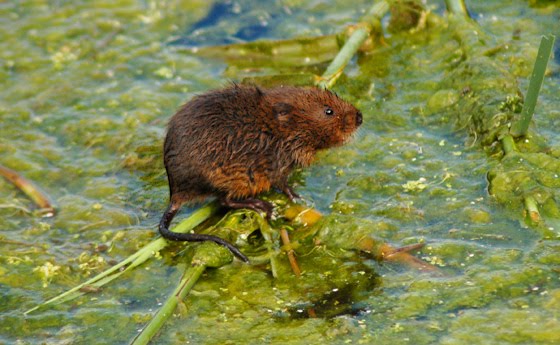We stopped by the Visitors Centre to pay for entry to the reserve and on arrival at the shingle beach the clouds began to recede and blue skies hugged the coastline for the remainder of the day. The reserve comprises of shingle beach, reedbeds, saltmarsh, saline lagoons which makes for an interesting landscape and one of the first specimens of vegetation to catch the eye were these striking Yellow Horned Poppy (Glucium flavum).
The long thin seedpods resemble horns, hence the name.
The waxy leaves have a hairy surface which enables the plant to retain moisture.
The wind was pretty strong so we were surprised to spot this female Grayling, as it lanaded on the shingle, a first for me, it settled into a hollow, its forewing tucked tightly into its hindwing as it sheltered from the wind.
Then a smaller butterfly stopped by, a female Common Blue sheltered down to bask amongst the shingle.
It wasn't just the butterflies that were making the most of the weather.
From the nearby hide, at a distance we saw 10 Spoonbill, Ruff, Green Sandpiper, Shelduck, Lapwing, Teal, Ringed Plover.
On the raised path between the marshy pools the flanking vegetation provided shelter for plenty of Common Blues, Gatekeepers and 10 or so Common Darters.
The moment we turned back we were confronted by a hobby or sparrowhawk flying along the channel next to us and in an instant it dove down into the reeds, according to the listings both birds are regularly spotted on the reserve.
After a pitstop return to the visitors centre we crossed the road to visit more hides. On crossing a bridge we heard a plop in the water below and spotted a Water Vole unconcerned by the attention and remained for approximately 5 minutes until the bridge was full of people before it decided to disappear.
A few metres away I got my first female Wall Brown together with the first Painted Lady of the year.
A few metres further a male Migrant Hawker at rest on vegetation.
To top it all off we popped into Cookies Crab Shop in Salthouse for a crab and crayfish salad, where two Marsh Harriers were spotted on the way.
As we were heading to Sheringham for an ice cream we spotted a number of birders with scopes heading down a lane, needless to say the ice cream took priority but on our return Andrea popped down to check out the fuss and caught a distant glimpse of a Lesser Grey Shrike, the talk of Norfolk birder for the rest of the week. Phew!



















Glad I looked in....Love Cley....love the East Bank (both happy memories)....and love the post Linda.
ReplyDeleteCracking shots of the Water Vole.
ReplyDeleteWow, you had a great day! Love the shots of the Water Vole and what a list of birds you saw. Fantastic to the see the Shrike too.
ReplyDeletePam
Linda, Looks like a great place to visit with so much variety to see. Super pics!
ReplyDeleteI visited Cley earlier this year for the first time and was blown away. A cracking account with some fine images, it took me back.
ReplyDeleteI love reed beds and remember hearing lots of "plopping" in the water one time but never saw the Water Voles so i really enjoy those images in particular.
Thanks
John
Hello Pete, its a smashing place isnt it, thanks for dropping by and thanks for your comments.
ReplyDeleteHello Paul, thanks, it was a treat to be able to watch it at such close proximity for so long. It was surprising how unbothered the vole was by its ever growing audience.
Hello Pam, it was a glorious day with so much to see, the hours just whizzed by!
Hello CB, Cley is a lovely place to visit and we were lucky with the weather which made for a great day out.
Hello Johnny, thanks very much, it seems to be a favourite spot with a lot of people, full of interesting habitats and a wide range of inhabitants.
Best wishes, Linda